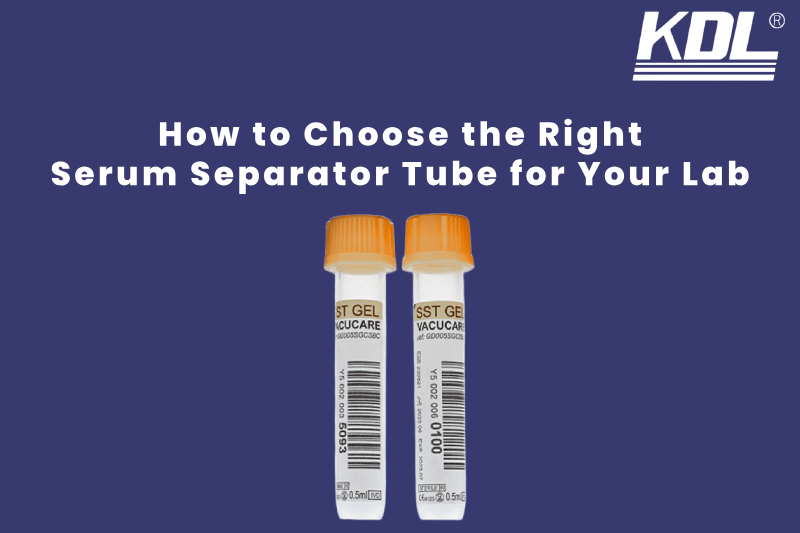
Accuracy and consistency are a must in any lab. Even though expensive analyzers and cutting-edge software frequently get all the attention, the reality is that even minor things, like the kind of serum separator tube you pick, may have a tremendous impact. Yes, the kind of tube you use does matter. whether you’ve ever questioned whether it does, the quick answer is yes.
In this article, we’ll show you how to choose the right serum separator tube in a simple and easy-to-understand method. This article will help you make smart decisions that lead to dependable findings, whether you’re a seasoned lab manager or a student just starting out.
What is a serum separator tube?
These tubes are used in clinical and research labs to collect blood and separate the serum from the rest of the sample. After the blood is drawn into the tube, it’s spun in a centrifuge. A special substance inside the tube—often a gel—creates a barrier between the serum and the blood cells. This clear separation makes it easier to test the serum for various health indicators.
Simple enough, right? But as it turns out, not all serum separator tubes are created equal. The one you choose can affect the quality of your test results, the safety of your procedures, and even how efficiently your lab operates.
Understanding the Importance of Choosing the Right Serum Separator Tube
Let’s break it down. Why does choosing the right serum separator tube matter so much?
Imagine running a series of tests only to find that the results are inconsistent—or worse, invalid—because the tube’s material interfered with the analyte. Or consider a busy lab where tubes crack in the centrifuge or leak during handling. Small mistakes in selection can lead to big problems, from wasted time and materials to misdiagnosis in a clinical setting.
A well-chosen tube supports
- Accurate, repeatable results
- Safe and smooth workflows
- Compatibility with your equipment
- Compliance with regulatory standards
And that’s why it’s worth taking the time to get your serum separator tube selection right from the start.
Key Features of Serum Separator Tube
- Color-Coded Cap: Usually yellow or gold
- Contains Clot Activator: Helps the blood to clot quickly
- Separation Gel: Creates a barrier between cells and serum
- Used for Serum Tests: No anticoagulants (blood thinners) inside
Types of Serum Separator Tube
This is one of the most common decisions in serum separator tube selection.
1. Gel Tubes: These make serum separation cleaner and more convenient. The gel barrier reduces the chance of contamination and allows you to easily decant or test the serum without disturbing the other parts of the blood sample.
2. Non-Gel Tubes: These are preferred when gel might interfere with sensitive analytes. They’re also used when you want to manually control the serum separation process.
In general, if you’re doing standard clinical tests, gel tubes are your go-to. But for research or highly sensitive assays, non-gel tubes might be the better fit.
Factors to Consider When Choosing Serum Separator Tube
Selecting the appropriate serum separator tube is essential for ensuring accurate laboratory test results and maintaining sample integrity. Here is a list of factors to consider when choosing a Serum Separator Tube.
1. Tube Material Quality
The material utilized is very important when picking a serum separator tube. Choosing a high-quality serum separator tube material for reliable results makes sure that the sample stays clean and stable. Medical-grade plastic or glass tubes limit chemical reactions and deterioration, which might make test results less accurate. Reliable materials also withstand centrifugation without breaking. This is important for labs focused on accurate and consistent diagnostic outcomes.
2. Clot Activator Presence
The clotting ability of a serum separator tube may directly affect how quickly things are done in a clinical context. A serum separator tube with fast clot activator performance speeds up clot formation. This reduces processing delays and improves test turnaround. Efficient clotting also prevents hemolysis, ensuring better serum quality. It is especially helpful in emergency or high-volume lab settings.
3. Gel Barrier Stability
A serum separator tube that works well must have a gel barrier that stays stable after being spun. Choose tubes with a stable gel barrier in serum separator tubes for accurate serum separation. This prevents the serum from mixing with blood cells. An unstable gel may shift and cause contamination. Stability is vital for tests that demand precise measurements.
4. Tube Volume and Fill Accuracy
The quality of the serum and the coagulation process depend on how much blood a tube can retain. Select correct serum separator tube volume for precise sample handling to ensure proper ratios. Overfilling or underfilling may affect clotting and reduce serum yield. The right volume improves accuracy and minimizes the need for repeat blood draws.
5. Compatibility with Lab Equipment
The amount of blood a tube can store has an effect on the serum and the process of clotting. To maintain the right blood-to-additive ratio, you need to utilize a correct serum separator tube capacity for exact sample handling. Proper compatibility helps maintain lab efficiency and equipment safety. Choose tubes that fit your centrifuge and analyzer racks for smooth operations.
6. Shelf Life and Storage Conditions
Another thing that people frequently forget is how long the tube stays useful and under what circumstances. Pick long shelf life serum separator tubes with stable storage requirements to reduce waste. Tubes should store well at room temperature or under standard lab conditions. This ensures the clot activator and gel stay effective over time.
7. Brand Reputation and Regulatory Compliance
You may feel safe knowing that you are buying tubes from well-known companies. It’s smart to buy certified serum separator tubes from well-known companies that satisfy international standards like ISO, CE, or FDA. These certifications make sure that the tubes are safe, dependable, and follow the greatest clinical procedures.
8. Cost-Effectiveness and Bulk Availability
Affordability is key in high-volume labs. Choose affordable bulk serum separator tubes for clinical labs to control costs without sacrificing quality. Many brands offer volume discounts with consistent performance. This is helpful for clinics, hospitals, or public labs with limited budgets.
Conclusion
The bottom line is? Choosing the right serum separator tubes isn’t just a little detail; it’s a key aspect of your lab’s success. Choosing the proper kind, size, and material makes sure that tests are accurate, operations go smoothly, and handling is safe. The tube you choose makes a big difference in the results, whether you’re doing everyday tests or cutting-edge research.
Do you need assistance choosing the proper lab supplies for serum analysis? At kdlnc, you can browse our reliable high-quality serum separator tubes and give your lab the confidence it needs.
 +86-791-8686-1216
+86-791-8686-1216 

